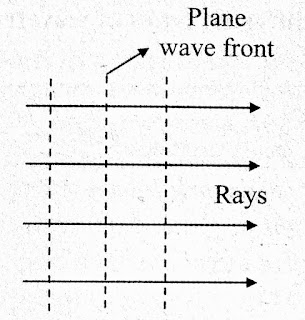So here first of all we know that,
What is the laws of reflection :
i) In the laws of reflection, the incident rays, reflected rays, and normal to the reflecting surface at the point of incidence, all lie in the same level.
ii) In the laws of reflection, the incident rays and the reflected rays lie on the opposite sides of the normal.
iii) The angle of incidence is equal or we can say equivalent to the angle of reflection.
For clear understanding the law of reflection in simple and easy way. So for that lets see the simple explanation about all these points.
Explanation :
i) The plane wavefront AB is developing at an angle towards plane reflecting surface XY.AA1 and BB1 are incident rays.
ii) When point 'A' come to XY at A1, than ray at 'B' reaches at point P and it has to cover distance PB1 to reach the reflecting surface XY.
iii) Let's consider 't' be the time to required to cover distance PB1.
In this time meantime, the secondary waves are emitted from the point A1 and it will spread over the hemisphere of the radius A1R in the same medium.
The distance covered by the secondary waves to reach from A1 to R in time 't' is same as the distance covered by the primary waves to reach from point P to B1.
So therefore A1R = PB1 = ct.
iv) All other rays in between AA1 and BB1 will reach XY after A1 and before B1. Therefore they will also emits secondary waves of the decreasing radii.
v) The surface touch all such hemispheres is RB1 which is reflected wavefront, bounded by the reflected rays A1R and B1Q.
vi) Let's draw A1M perpendicular to XY and B1N perpendicular to XY.
Thus, the angle of incidence is angle AA1M = angle BB1N = i and the angle of reflection is angle MA1R = angle NB1Q = r.
angle RA1B1 = 90 - r
angle PB1A1 = 90 - i
vii) In the triangle A1RB1 and triangle A1PB1
Here angle A1RB1 congruent to angle A1PB1
A1R = PB1,............ (Reflected waves travel in equal in same medium in equal time).
A1B1 = A1B1.........(Common side)
Therefore triangle A1RB1 congruent to triangle A1PB1
Therefore angle RA1B1 = angle PB1A1
Therefore 90 - r = 90 - i
Therefore i = r
viii) From the above given figure, it clear that the incident ray, reflected ray and normal lie in the same level or plane.
ix) This laws of reflection of light from the plane reflecting surface on the basis of Huygen's wave theory.
THE END
Thank you










